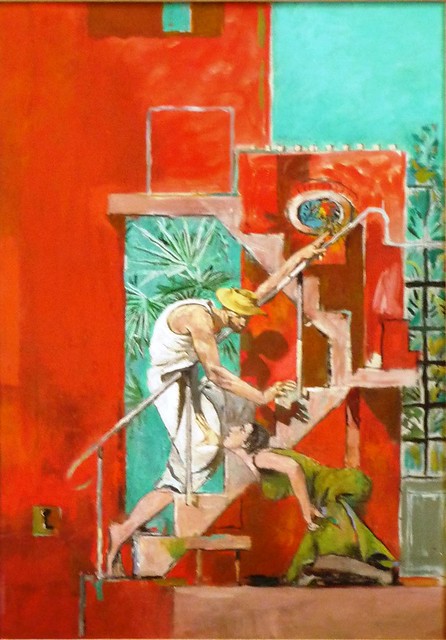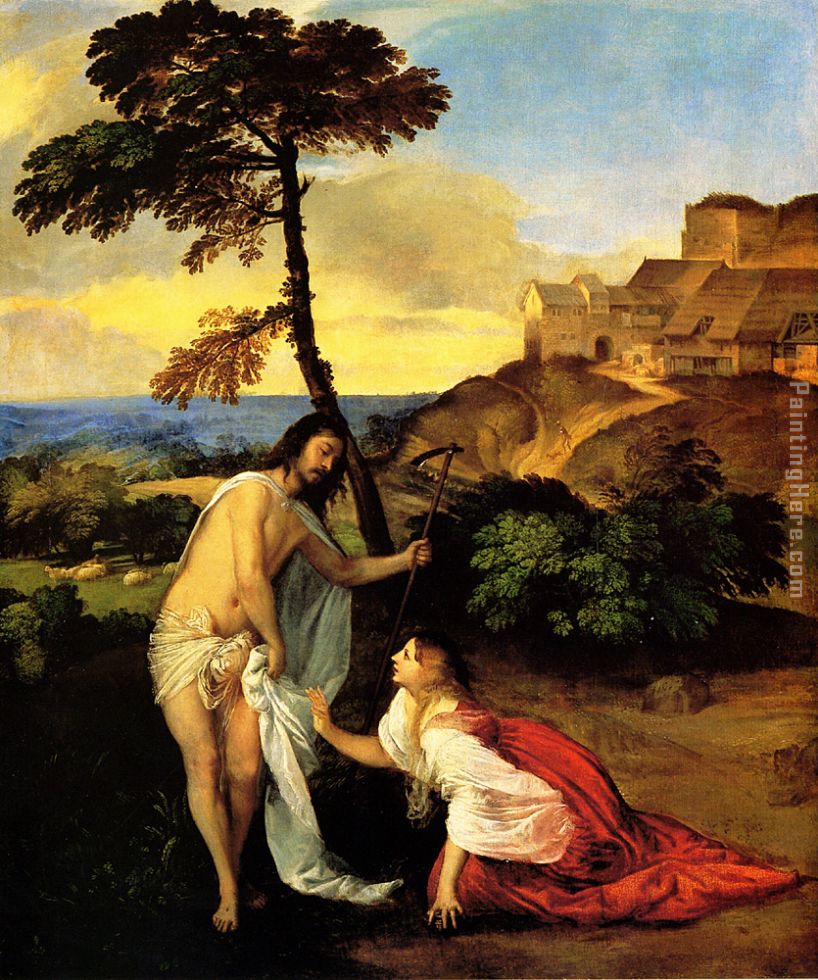by Madi Barker
Sutherland’s use of colour is striking against the contrast of its cold, beige limestone backdrop of the Cathedral walls. Coral red dominates the canvas: its sinister modern connotations make the colour a seemingly unusual choice. Yet perhaps Sutherland is harking back to religious symbolism: the scarlet within Noli me tangere reflects Jesus’ sacrifice – the blood he spilt is an unavoidable element of our absolution while the blood we have split bears no necessity. The red geometric interior contrasts with the green naturalistic garden, and yet the spaces mesh – they are divided but one can move between them. Mary is entirely framed against red – denoting her limitation to earth – while the figure of Jesus crosses between the two spaces, reaching over the barrier of the staircase to engage with Mary. Notably, Titian also wraps Mary in red cloth. Both artists are perhaps explicitly gesturing towards her reputation as a scarlet woman. Sutherland contorts her voluptuous body into a sexually provocative position, extending her neck upwards through disbelief. Regardless, she is redeemed: in the setting of a garden, her lime dress symbolises rebirth and she seems vulnerable. Although Sutherland may acknowledge the crimes of humanity within Noli me tangere, he does not condemn them but rather, through Jesus’ divinity, realises that our salvation can be achieved only through proximity to the Lord.
 |
| Noli Me Tangere, Graham Sutherland, 1961 Chichester Cathedral (Click to enlarge) |
Jesus’ plea of ‘noli me tangere’ (literally translated as ‘don’t touch me’) has inspired many artists to return to this moment of suspense. Yet, Sutherland (1903 – 1980) defied classical depictions of the biblical scene: his internal turmoil, caused by the horrors of war, led him to reimagine the Gospel as vibrant, angular and complex. Some may argue his recreation of this iconic image of redemption became his personal form of atonement.
Contrasting to Sutherland’s pre-war neo-romantic style, Noli me tangere has a geometric composition; each line overlaps another to form a kaleidoscope of shape. Both Sutherland and his contemporary, Francis Bacon (1909 – 1992), use geometrical constructions within their work. Bacon’s content is dark, using shapes to isolate and cage figures (as one can see from Bacon’s Study After Velázquez’s Portrait of Pope Innocent X), while the abstract nature of Sutherland’s style gestures subtly towards religious symbolism. For example, the painting itself is asymmetrical, allowing the perpendicular meeting of the diagonal handrail and second level of the staircase to form a transverse cross. Jesus’ figure hangs upon this construction, his body creating a strong diagonal line pointing upwards but his gaze and gentle, yet firm, gesture downward emphasises the tension between the two figures. The form of Jesus’ raised arm is reminiscent of Michelangelo’s The Creation of Adam: through the most delicate part of the human body, Christ is shown to reconnect us to the God we betrayed.
The angle between the ascending staircase and the vertical line of the doorway meet to form a triangle, with the figure of Jesus contained inside. Sutherland depicts the Holy Trinity at the heart of his work, perhaps echoing his own dedication. Each stair is in itself a triangle, leading to the faint blue outline of a square: the angular nature of the painting seems predictable and logical, and therefore consoling after a period of great inhumanity. The painting is balanced by turquoise signifying the presence of the divine. Without blemish, the interruptions of blue symbolise the removal of human sin - when Jesus is present, the sky is clear. Perceivably, Sutherland comments on our desire to play God, regardless of our inevitable sin, and thus our natural inclination to create hell. The figure's positions are extremely similar to Titian’s Noli me tangere (1512) (see below)
The centres of both canvases are held in suspense, as both hands reach outwards yet do not yearn to meet. Sutherland’s setting, however, is cynical towards human tendencies, unlike Titian’s forgiving pastoral scene. Despite a smooth and uniformly thin use of paint, the impasto technique is used for Jesus’ form. The thickness of paints gradually accumulates towards the centre of the canvas. This technique deepens the folds within his garments and creates texture in his pale, mottled skin. The result is an ironically tangible element to the figure that demands to remain untouched: Sutherland’s technique seduces both Mary Magdalene and the viewer by the corporeal reality of a deity. Jesus cannot be recognised by any of the traditional symbols, posing himself as a modest gardener who is unmistakable as the Son of God. Significantly, and perhaps nostalgically, Sutherland uses Titian’s original symbol of a hat (later changed to a hoe).
The angle between the ascending staircase and the vertical line of the doorway meet to form a triangle, with the figure of Jesus contained inside. Sutherland depicts the Holy Trinity at the heart of his work, perhaps echoing his own dedication. Each stair is in itself a triangle, leading to the faint blue outline of a square: the angular nature of the painting seems predictable and logical, and therefore consoling after a period of great inhumanity. The painting is balanced by turquoise signifying the presence of the divine. Without blemish, the interruptions of blue symbolise the removal of human sin - when Jesus is present, the sky is clear. Perceivably, Sutherland comments on our desire to play God, regardless of our inevitable sin, and thus our natural inclination to create hell. The figure's positions are extremely similar to Titian’s Noli me tangere (1512) (see below)
The centres of both canvases are held in suspense, as both hands reach outwards yet do not yearn to meet. Sutherland’s setting, however, is cynical towards human tendencies, unlike Titian’s forgiving pastoral scene. Despite a smooth and uniformly thin use of paint, the impasto technique is used for Jesus’ form. The thickness of paints gradually accumulates towards the centre of the canvas. This technique deepens the folds within his garments and creates texture in his pale, mottled skin. The result is an ironically tangible element to the figure that demands to remain untouched: Sutherland’s technique seduces both Mary Magdalene and the viewer by the corporeal reality of a deity. Jesus cannot be recognised by any of the traditional symbols, posing himself as a modest gardener who is unmistakable as the Son of God. Significantly, and perhaps nostalgically, Sutherland uses Titian’s original symbol of a hat (later changed to a hoe).
Sutherland’s use of colour is striking against the contrast of its cold, beige limestone backdrop of the Cathedral walls. Coral red dominates the canvas: its sinister modern connotations make the colour a seemingly unusual choice. Yet perhaps Sutherland is harking back to religious symbolism: the scarlet within Noli me tangere reflects Jesus’ sacrifice – the blood he spilt is an unavoidable element of our absolution while the blood we have split bears no necessity. The red geometric interior contrasts with the green naturalistic garden, and yet the spaces mesh – they are divided but one can move between them. Mary is entirely framed against red – denoting her limitation to earth – while the figure of Jesus crosses between the two spaces, reaching over the barrier of the staircase to engage with Mary. Notably, Titian also wraps Mary in red cloth. Both artists are perhaps explicitly gesturing towards her reputation as a scarlet woman. Sutherland contorts her voluptuous body into a sexually provocative position, extending her neck upwards through disbelief. Regardless, she is redeemed: in the setting of a garden, her lime dress symbolises rebirth and she seems vulnerable. Although Sutherland may acknowledge the crimes of humanity within Noli me tangere, he does not condemn them but rather, through Jesus’ divinity, realises that our salvation can be achieved only through proximity to the Lord.
 |
| Noli Me Tangere, Tiziano Vecellio (Titian), c. 1512, National Gallery ( Click to enlarge ) |
Comments
Post a Comment
Comments with names are more likely to be published.